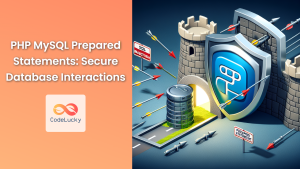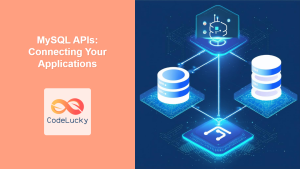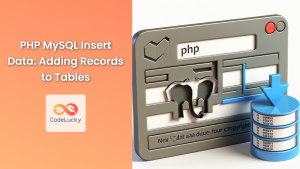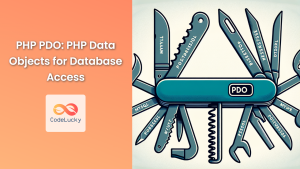In the world of web development, PHP and MySQL form a powerful duo, enabling developers to create dynamic, data-driven websites. One of the fundamental skills every PHP developer must master is establishing a connection between PHP and MySQL. This article will guide you through the process of creating a robust PHP MySQL connection, exploring different methods and best practices.
Understanding PHP MySQL Connections
Before we dive into the code, let's understand what a PHP MySQL connection really means. When your PHP script needs to interact with a MySQL database, it needs to establish a connection. This connection acts as a bridge, allowing your PHP code to send queries to the database and receive results.
🔗 A PHP MySQL connection is like a secure phone line between your PHP application and the MySQL database server.
Methods for Establishing a PHP MySQL Connection
There are primarily two ways to connect PHP with MySQL:
- MySQLi (MySQL Improved Extension)
- PDO (PHP Data Objects)
Let's explore both methods in detail.
1. MySQLi Connection
MySQLi is a powerful, object-oriented extension that was introduced with PHP 5. It provides a more efficient and feature-rich way to interact with MySQL databases compared to the older mysql extension (which is now deprecated).
Here's how you can establish a connection using MySQLi:
<?php
$servername = "localhost";
$username = "your_username";
$password = "your_password";
$dbname = "your_database";
// Create connection
$conn = new mysqli($servername, $username, $password, $dbname);
// Check connection
if ($conn->connect_error) {
die("Connection failed: " . $conn->connect_error);
}
echo "Connected successfully";
// Close the connection when done
$conn->close();
?>
Let's break down this code:
- We start by defining our connection parameters: server name, username, password, and database name.
- We create a new mysqli object, passing these parameters.
- We check if the connection was successful. If not, we terminate the script and display an error message.
- If the connection is successful, we echo a success message.
- Finally, we close the connection when we're done.
🚀 Pro Tip: Always close your database connections when you're finished to free up resources and improve your application's performance.
2. PDO Connection
PDO is a more versatile option as it allows you to work with multiple database systems using the same code. This makes it easier to switch between different databases if needed.
Here's how to establish a connection using PDO:
<?php
$servername = "localhost";
$username = "your_username";
$password = "your_password";
$dbname = "your_database";
try {
$conn = new PDO("mysql:host=$servername;dbname=$dbname", $username, $password);
// set the PDO error mode to exception
$conn->setAttribute(PDO::ATTR_ERRMODE, PDO::ERRMODE_EXCEPTION);
echo "Connected successfully";
} catch(PDOException $e) {
echo "Connection failed: " . $e->getMessage();
}
// Close the connection when done
$conn = null;
?>
Let's analyze this code:
- We define our connection parameters as before.
- We use a try-catch block to handle potential connection errors gracefully.
- Inside the try block, we create a new PDO object with our connection details.
- We set the error mode to exception, which allows us to catch and handle errors more effectively.
- If the connection is successful, we echo a success message.
- If an error occurs, it's caught in the catch block, and we display the error message.
- Finally, we close the connection by setting $conn to null.
🛡️ Security Note: PDO supports prepared statements, which help protect against SQL injection attacks.
Comparing MySQLi and PDO
Both MySQLi and PDO have their strengths. Here's a quick comparison:
| Feature | MySQLi | PDO |
|---|---|---|
| Database Support | MySQL only | Multiple databases |
| API | Object-oriented and procedural | Object-oriented only |
| Named Parameters | No | Yes |
| Performance | Slightly faster | Slightly slower |
| Prepared Statements | Yes | Yes |
Best Practices for PHP MySQL Connections
-
Use Connection Pooling: For high-traffic websites, consider using connection pooling to reuse existing connections rather than creating new ones for each request.
-
Store Credentials Securely: Never hardcode database credentials in your PHP files. Instead, use configuration files or environment variables.
-
Handle Errors Gracefully: Always check for connection errors and handle them appropriately to prevent your application from crashing.
-
Use Prepared Statements: To protect against SQL injection attacks, always use prepared statements when executing SQL queries.
-
Close Connections: Always close your database connections when you're done using them to free up server resources.
Creating a Reusable Connection Function
To make your code more maintainable, you can create a reusable function for database connections. Here's an example using PDO:
<?php
function connectDB() {
$servername = "localhost";
$username = "your_username";
$password = "your_password";
$dbname = "your_database";
try {
$conn = new PDO("mysql:host=$servername;dbname=$dbname", $username, $password);
$conn->setAttribute(PDO::ATTR_ERRMODE, PDO::ERRMODE_EXCEPTION);
return $conn;
} catch(PDOException $e) {
die("Connection failed: " . $e->getMessage());
}
}
// Usage
$conn = connectDB();
// Use $conn for your database operations
// ...
$conn = null; // Close the connection
?>
This function encapsulates the connection logic, making it easy to establish connections throughout your application.
Testing Your Connection
Once you've established a connection, it's a good practice to test it by running a simple query. Here's how you can do this:
<?php
$conn = connectDB(); // Assuming you're using the function from the previous example
try {
$stmt = $conn->query("SELECT 1");
$result = $stmt->fetch(PDO::FETCH_ASSOC);
if ($result) {
echo "Database connection test successful!";
}
} catch(PDOException $e) {
echo "Query failed: " . $e->getMessage();
}
$conn = null; // Close the connection
?>
This script attempts to run a simple SELECT query. If it succeeds, we know our connection is working correctly.
Troubleshooting Common Connection Issues
Even with careful coding, you might encounter connection issues. Here are some common problems and their solutions:
-
"Access denied" errors: Double-check your username and password. Ensure the user has the necessary permissions on the database.
-
"Host not found" errors: Verify your server name. If you're using 'localhost', try using '127.0.0.1' instead.
-
"Unable to connect" errors: Make sure your MySQL server is running and that you're not blocked by a firewall.
-
Slow connections: If your connections are slow, check your server's performance and consider optimizing your database queries.
Conclusion
Establishing a solid PHP MySQL connection is the foundation of any database-driven PHP application. Whether you choose MySQLi or PDO, understanding how to create, manage, and optimize these connections is crucial for building efficient and secure web applications.
Remember, the choice between MySQLi and PDO often comes down to personal preference and project requirements. PDO offers more flexibility with its support for multiple databases, while MySQLi provides a slight performance edge for MySQL-specific projects.
By following the best practices outlined in this article and regularly testing your connections, you'll be well-equipped to handle database operations in your PHP applications. Happy coding!
🌟 CodeLucky Tip: Practice makes perfect! Try creating different types of connections and experiment with various database operations to solidify your understanding of PHP MySQL connections.



















